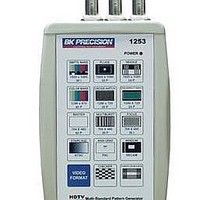1253 B&K Precision, 1253 Datasheet - Page 10

1253
Manufacturer Part Number
1253
Description
GENERATOR HANDHELD HDTV PATTERN
Manufacturer
B&K Precision
Type
NTSC Handheldr
Specifications of 1253
Patterns
ANSI, Bar, Checker, Crosshatch, Focus, Multiburst, Needle, PLUGE, Raster, Staircase, Window
Connection Method
BNC, S-Video
Power Source
9V Battery
Equipment Type
NTSC Color Generator
Lead Free Status / Rohs Status
Lead free / RoHS Compliant
Available stocks
Company
Part Number
Manufacturer
Quantity
Price
Company:
Part Number:
1253
Manufacturer:
GERMENY
Quantity:
5 532
Company:
Part Number:
1253-6758-LF
Manufacturer:
JST
Quantity:
1 000
Company:
Part Number:
125329-HMC785LP4E
Manufacturer:
HITTITE
Quantity:
1 400
Company:
Part Number:
12532WR-04
Manufacturer:
YEONHO
Quantity:
1 474
Company:
Part Number:
12532WR-07(HF)
Manufacturer:
VISHAY
Quantity:
18 862
Part Number:
1253AY-2R2N=P3
Manufacturer:
MURATA/村田
Quantity:
20 000
Part Number:
1253AY-6R8M=P3
Manufacturer:
MURATA/村田
Quantity:
20 000
3: Needle
Description:
This pattern is black on the top half and white on bottom half, with lines (needle pulses)
drawn from top to bottom on each side of the pattern, through the black/white transition. Electrically, the
needle pulse lines are the same width on the top and the bottom of the pattern.
Pattern Usage:
This pattern makes it easy to detect whether scan velocity modulation (SVM) is enabled
on a display device. If SVM is enabled, the black lines on the bottom of the pattern will be thicker than
the white lines on the top of the pattern. It is also a good pattern for properly adjusting the
contrast/picture/white level control for maximum white luminance level. If the contrast/picture control is
adjusted for a higher white level than the display device is capable of producing properly, one of two
distortion effects will be observed; blooming or raster distortion. Blooming is especially prevalent in CRT
displays and results in light from very bright pixels (phosphors) spilling over to adjacent pixels. This
causes bright picture areas to become defocused and slightly larger than they should be.
Raster distortion at high luminance levels is caused by high voltage power supply regulation problems. If
the contrast/picture control is adjusted for a higher white level than the display power supply is capable of
fully supporting on a short-term basis, the black lines on the bottom of the pattern will hook or bend
outward.
Ideally, for an accurate picture, the contrast/picture control should be adjusted just below the point at
which either blooming or raster distortion is evident. This may result in an unacceptably low white level
for the picture, however, and a compromise white level adjustment may have to be made between an
accurate picture and a bright picture.
Examples of Uncalibrated Displays:
The following images indicate a TV with incorrect settings, shown
by the Needle pattern. The first image has outwardly bent lines. The Contrast/picture levels may be set too
high, or the TV may have poor power supply regulation.
The second image shows blooming, where the white lines appear thicker than the black lines. Correct this
by adjusting the contrast/white level.
Blooming White lines
Bent Lines











